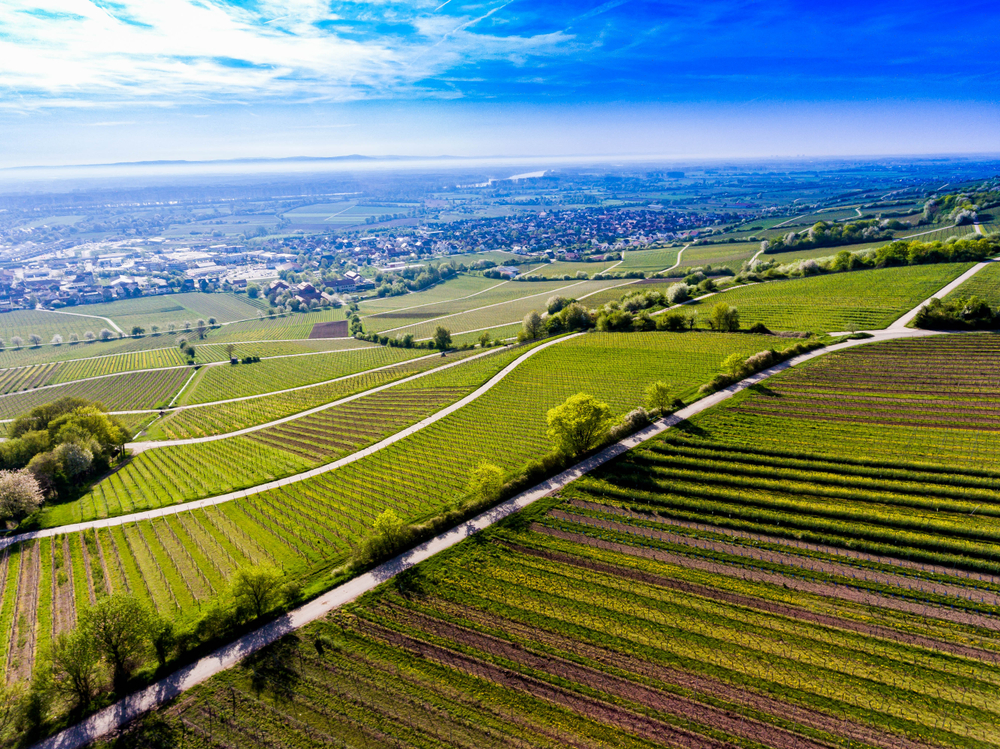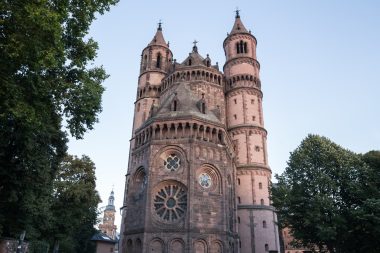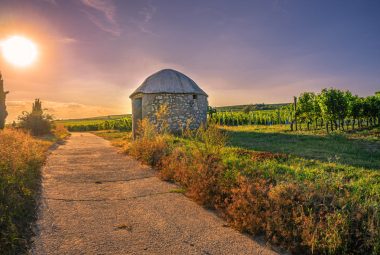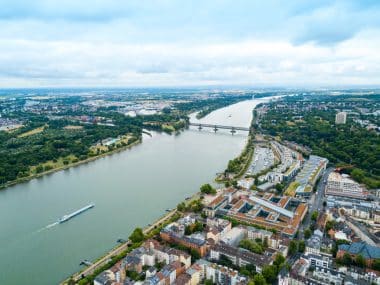
Green mountains and a lovely river valley: Rheinhessen is a paradise for romantic poets, painters and singers – good for those who explore this part of the Palatinate Rhineland on foot or by bike. So you can confidently enjoy a glass of wine in between.
Rheinhessen stands for enjoyment and a natural experience. Wine is omnipresent here. Winegrowers open their inns, which often serve as hostels, and charming little towns invite you to linger. Middle Rhine romanticism and wide views – Goethe already felt at home here. If you want to explore this region, you should plan at least a week.
Between wine and rocks – welcome to the “Land of a Thousand Hills”

First of all: We are not in Hesse, as the name might suggest! Since the Congress of Vienna (1815), Rhenish Hesse has belonged to the Palatinates of the Rhineland. Fields and forests, gentle bumps, meadows often overgrown with vines, many small villages built of sandstone – Rheinhessen is like a sea: many pearls are waiting to be discovered. Vineyard after vineyard. On the journey from Bingen via Alzey to Worms, the holidaymaker will find a gentle hilly landscape. Again and again it goes uphill and downhill.
Who wants to float over a vineyard landscape with the cable car? Visit a flower gift paradise, wine hiking, great festivals and special wine experiences – it’s time to discover the German Puglia !
Holidays in “Weinhessen” – a touch of the Mediterranean
In Rheinhessen, the large anemone forms a flower beauty. It loves the warmth. In this respect, there is much to be said for the region’s climate favour. Spring begins earlier here, autumn defies winter for a long time. Rheinhessen is rightly considered the Tuscany in the middle of Germany. Juicy figs, racy wines, sweet almonds and lemons thrive here. The climate is almost Mediterranean. White pointed cap-like buildings are reminiscent of Puglia in southern Italy. The white sugar loafs – also known as trulli – peek out of the vineyard landscape near Flörsheim-Dalsheim and are at the same time the trademark of southern Rheinhessen. A trullo hike on every third Sunday in June is recommended. Numerous visitors then flock to the vineyard cottages with the white hats to watch their cultivation.

From Bingen upstream, the valley of the Rhine widens. Between the bend of the Rhine and the border with Alsace stretches the huge Rhine construction region of Rheinhessen.
In the sunny climate of the Palatinate, the noble grape juice matures, bringing people together in cosy wine taverns. Cool vaulted cellars everywhere invite you to a hearty wine tasting. The “Rhine Franconian” turns out to be a hospitable, fun-loving breed of people. The region is characterized by a 2000-year-old cultural history. The wine also leads again and again in the footsteps of the Romans. There is hardly a place without vines. The Romans introduced it, and the Franks subsequently cultivated it.
Famous places in the sunny hill country

Discover special places and enjoy beautiful moments – Rheinhessen invites:
Let’s start with the big names in the wine world: Mainz, Oppenheim, Ingelheim and Nierstein. All major towns are well connected by public transport. Many explore the area by muscle power or by e-bike. Above all, however, it is the “Wandersleut” who are increasingly discovering Rheinhessen.
Nieder-Olm, Sprendlingen and Wörrstadt form the heart of the region. Alzey likes to act as the secret capital of Rheinhessen.
Just a stone’s throw and you reach the Jewish Worms or the legendary Nibelungen, which is soon joined by the Wonnegau. The cathedral city of Worms is not only the home of the Nibelungen, Luther also stood here in 1521 in front of the Reichstag and spoke the well-known sentence: “Here I stand. I can’t help it…”.
And then there is the Eicher See, also known as the “Rhine-Hessian Sea”, followed by the Romanesque Lambertus Basilica in Bechtheim or the city wall in Dalsheim. There is a lot to discover.
Let’s linger for a moment in Northern Rhine-Hesse – in Bingen! Here, where the home of the “Heilgen Hildegard” is, the Rhine squeezes through a mountain strait to the north. The legendary Mouse Tower was once a toll tower, i.e. a customs tower. And contrary to what the imposing tradition would suggest, it does not stand at lofty heights, but on the Rhine, or rather in the Rhine, and is more of a left bank of the left bank of the Rhine of Ehrenfels Castle. Of course, even a mouse tower does not change the fact that the Rhine-romantic enthusiasm is ignited by the hilltop castles.
Mainz , meanwhile, convinces with its pretty banks of the Rhine, the Kirschgartenplatz and the many Mainz wine bars. A guided tour of the city is recommended. Mainz is a charming city with many sights.
3 places straight out of a fairy tale – over hill and dale and Hiwwel
“Hiwwel” – that’s what the hills in Rheinhessen are called. There are a total of nine of these hills, two of which are located in northern Rheinhessen. Near Ingelheim, so-called “Hiwwelwanderungen” lead through the largest wine-growing region in Germany.
At Appenheim, the table is always open for hikers. Appenheim is a magical place and at the same time a real Rhine-Hessian resting place. How about wine loungers in the Appenheimer Hundertgulden? Once a month, the stone wall becomes a bar and guests enjoy a glass of wine in a horizontal position with a breathtaking view.
Shielding yourself from the outside world and diving in for a moment: If you are looking for idyllic hiking trails, you will find them in the hollow paths of Westerberg. Once upon a time, heavy carts were pulled here by oxen and horses. Today, the narrow biotopes surprise with a special plant world.
Tip: There is a barrel in Schwabenheim – a special barrel. The idea is terrific: In the barrel there is a refrigerator filled with delicious wines from the Schuck winery. Guests can treat themselves to a drink at any time and leave a donation on the basis of trust.
Top sights in Rheinhessen at a glance:
- City wall in Dalsheim
- Flonheimer Trullo
- Jewish cemetery in Worms
- St. Peter’s Cathedral in Worms
- Oppenheim Underworlds
- St. Martin’s Cathedral in Mainz
- Roter Hang in Nierstein
- Bingen Kulturufer
- Leaning Tower of Gau-Weinheim
- Imperial Palace in Ingelheim
Rheinhessen cuisine – a feast for the eyes and palate
Rheinhessen combines three components: wine, customs and food.
Tips for a cosy stop:
Café Augenwaide in Flörsheim-Dalsheim
There is something for all the senses here. The Flower Gifts Paradise opens the round. Ideally, you would like to take everything home with you. The offer is overwhelmingly beautiful. You then reach a charming complex with a garden. Pure relaxation: With coffee and cake, you can watch the sheep graze.
Wasem’s Engelthal Monastery
A good wine at the right time. The monastery is not an ordinary monastery, it is a wine experience world. Hospitality, conviviality and enjoyment – browse, stroll and stop off at the monastery restaurant. At the monastery brunch, guests experience unforgettable culinary delights. Some people want to stay longer. Why not? The rustic wine hotel invites you to a wonderful stay with its comfortably furnished rooms.
Morstein Estate
The chambers of the Morstein estate are no less inspiring. The listed winery is located in the centre of Westhofen. In the courtyard there is a charming restaurant with a beautiful garden. Here you not only feast and snooze comfortably, but also get married here. The estate is the perfect wedding location in Rheinhessen.
Good to know: Rhine-Hessian specialties include potato cake, Spundekäs, asparagus ragout with herb noodles and Handkäs with music, which is so called because it produces digestive sounds thanks to its high proportion of sour milk cheeses.
Result: Rheinhessen is always worth a visit. The people are warm, the food tastes good and the wine is delicious. The region is undoubtedly one of the most beautiful areas in Germany.

